What We’re Reading: March 24
Have you seen an exciting new paper you’d like to summarize for the community? Contact Mary Williams to inquire about contributing to this series!
Reviews: Nature Insight: Plants ($)
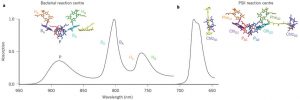 Nature journal published a special “Plant Insights” section featuring several excellent reviews. Zipfel and Oldroyd review Plant signalling in symbiosis and immunity (10.1038/nature22009), Bevan et al. write about Genomic innovation for crop improvement (10.1038/nature22011), Scheres and van der Putten write about how The plant perceptron connects environment and development (10.1038/nature22010), and Romero et al. describe the Quantum design of photosynthesis for bio-inspired solar-energy conversion (10.1038/nature22012). It’s a great collection of articles to help scientists and students to catch up on exciting research developments. Tags: Applied Plant Biology, Bioenergetics, Biotic Interactions, Development, Education and Outreach, Genomics
Nature journal published a special “Plant Insights” section featuring several excellent reviews. Zipfel and Oldroyd review Plant signalling in symbiosis and immunity (10.1038/nature22009), Bevan et al. write about Genomic innovation for crop improvement (10.1038/nature22011), Scheres and van der Putten write about how The plant perceptron connects environment and development (10.1038/nature22010), and Romero et al. describe the Quantum design of photosynthesis for bio-inspired solar-energy conversion (10.1038/nature22012). It’s a great collection of articles to help scientists and students to catch up on exciting research developments. Tags: Applied Plant Biology, Bioenergetics, Biotic Interactions, Development, Education and Outreach, Genomics
Review: Impact of the ion transportome of chloroplasts on the optimization of photosynthesis ($)
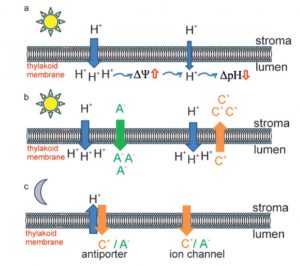 In photosynthesis, light energy generates proton motive force (pmf) across the thylakoid membrane. The establishment and maintenance of pmf involves numerous membrane transporters as well as other ions. Szabò and Septea review how various ions (including K+, Na+, Fe2+, Cu+, Mn2+, Ca2+, Cl–) contribute to photosynthetic efficiency, the approximate range of concentrations of each of these ions in various chloroplast compartments, and the transporters that enable them to cross membranes. The impact of the ion transportome on non-photochemical quenching (NPQ) is also discussed. J. Exp. Bot. 10.1093/jxb/erx063 Tags:, Biochemistry, Bioenergetics, Physiology, Transport
In photosynthesis, light energy generates proton motive force (pmf) across the thylakoid membrane. The establishment and maintenance of pmf involves numerous membrane transporters as well as other ions. Szabò and Septea review how various ions (including K+, Na+, Fe2+, Cu+, Mn2+, Ca2+, Cl–) contribute to photosynthetic efficiency, the approximate range of concentrations of each of these ions in various chloroplast compartments, and the transporters that enable them to cross membranes. The impact of the ion transportome on non-photochemical quenching (NPQ) is also discussed. J. Exp. Bot. 10.1093/jxb/erx063 Tags:, Biochemistry, Bioenergetics, Physiology, Transport
Review: Palaeobotanical redux: revisiting the age of the angiosperms
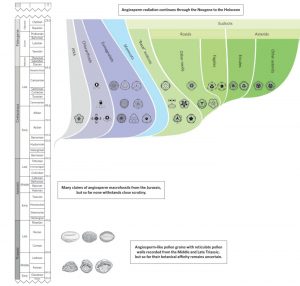 Although angiosperms are the dominant autotrophs in most parts of the world, their evolutionary origins remain somewhat mysterious. Herendeen et al. review the earliest evidence for angiosperms from the Early Cretaceous, and discuss fossil remains from earlier periods (Jurassic, Triassic) that have some angiosperm-like features. They conclude that none of these earlier fossils are unambiguously angiosperms, although they don’t rule out the possibility that one day a pre-Cretaceous angiosperm fossil will be found. Nature Plants 10.1038/nplants.2017.15 Tags: Botany, Evolution
Although angiosperms are the dominant autotrophs in most parts of the world, their evolutionary origins remain somewhat mysterious. Herendeen et al. review the earliest evidence for angiosperms from the Early Cretaceous, and discuss fossil remains from earlier periods (Jurassic, Triassic) that have some angiosperm-like features. They conclude that none of these earlier fossils are unambiguously angiosperms, although they don’t rule out the possibility that one day a pre-Cretaceous angiosperm fossil will be found. Nature Plants 10.1038/nplants.2017.15 Tags: Botany, Evolution
Update: Transitory starch metabolism in guard cells: unique features for a unique function
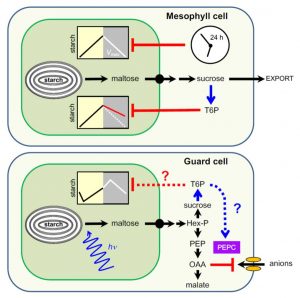 In leaf mesophyll cells, some of the sugars produced by photosynthesis are stored as transitory starch, which is then broken down to provide the cells with energy during the night. Recent advances in imaging and staining and the use of mutants have enabled the pattern of accumulation of transitory starch in guard cells to be determined. Santelia and Lunn review these new insights and the special role of starch catabolism products (including malate) in stomatal opening in the light. The authors conclude, “Our aim in this review has been to highlight the exciting recent advances in our understanding of guard cell metabolism, with the hope of persuading young researchers to fall in love with stomata, and take up the challenge to explore their fascinating biology.” Plant Physiol. 10.1104/pp.17.00211 Tags: Genetics, Metabolism, Physiology
In leaf mesophyll cells, some of the sugars produced by photosynthesis are stored as transitory starch, which is then broken down to provide the cells with energy during the night. Recent advances in imaging and staining and the use of mutants have enabled the pattern of accumulation of transitory starch in guard cells to be determined. Santelia and Lunn review these new insights and the special role of starch catabolism products (including malate) in stomatal opening in the light. The authors conclude, “Our aim in this review has been to highlight the exciting recent advances in our understanding of guard cell metabolism, with the hope of persuading young researchers to fall in love with stomata, and take up the challenge to explore their fascinating biology.” Plant Physiol. 10.1104/pp.17.00211 Tags: Genetics, Metabolism, Physiology
Review: The systems biology of auxin in developing embryos ($)
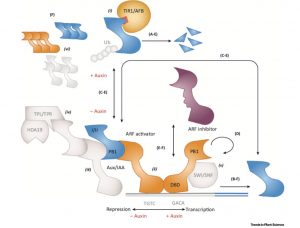 The transcriptional response to auxin depends in large part on the interactions between ARF transcription factors and the Aux/IAA transcription inhibitors that interact with them. The crucial role of auxin in embryo patterning is revealed by the embryo patterning defects observed in mutants of ARF and Aux/IAA proteins as well as auxin synthesis and transport mutants. Mironova et al. review recent research into the role of auxin in embryo development, focusing on mathematical and structural models of auxin signaling, and particularly how a better understanding of the interactions amongst and between ARFs and Aux/IAA proteins enhances modeling efforts. Trends Plant Sci. 10.1016/j.tplants.2016.11.010 Tags: Biochemistry, Computational Biology, Development, Signals and Responses, Systems Biology
The transcriptional response to auxin depends in large part on the interactions between ARF transcription factors and the Aux/IAA transcription inhibitors that interact with them. The crucial role of auxin in embryo patterning is revealed by the embryo patterning defects observed in mutants of ARF and Aux/IAA proteins as well as auxin synthesis and transport mutants. Mironova et al. review recent research into the role of auxin in embryo development, focusing on mathematical and structural models of auxin signaling, and particularly how a better understanding of the interactions amongst and between ARFs and Aux/IAA proteins enhances modeling efforts. Trends Plant Sci. 10.1016/j.tplants.2016.11.010 Tags: Biochemistry, Computational Biology, Development, Signals and Responses, Systems Biology
Cell-autonomously controlled ground tissue initiation by auxin in early Arabidopsis embryo ($)
 MONOPTEROS is an auxin-response factor (ARF) that is necessary for root formation during early embryogenesis. Its activity is modulated by BODENLOS (BDL), an Aux/IAA protein that is degraded in the presence of auxin. Möller et al. investigated the transcriptional targets of MP in very early embryos through the cell-specific expression of a stabilized BDL protein (bdl), which leads to a decrease in expression level of MP targets. The authors showed that MP targets include auxin-regulated genes and several transcription factors. Furthermore, they identified several MP targets that are crucial for ground tissue establishment, and showed that MP acts cell-autonomously in the specification of ground tissue and vascular tissue and that tissue initiation and tissue patterning can be regulated separately. Proc. Natl. Acad. Sci. 10.1073/pnas.1616493114 Tags: Development, Gene Expression, Signals and Resonses
MONOPTEROS is an auxin-response factor (ARF) that is necessary for root formation during early embryogenesis. Its activity is modulated by BODENLOS (BDL), an Aux/IAA protein that is degraded in the presence of auxin. Möller et al. investigated the transcriptional targets of MP in very early embryos through the cell-specific expression of a stabilized BDL protein (bdl), which leads to a decrease in expression level of MP targets. The authors showed that MP targets include auxin-regulated genes and several transcription factors. Furthermore, they identified several MP targets that are crucial for ground tissue establishment, and showed that MP acts cell-autonomously in the specification of ground tissue and vascular tissue and that tissue initiation and tissue patterning can be regulated separately. Proc. Natl. Acad. Sci. 10.1073/pnas.1616493114 Tags: Development, Gene Expression, Signals and Resonses
Coordination of auxin-triggered leaf initiation by tomato LEAFLESS ($)
 Capua and Eshed explored the link between auxin and leaf initiation at the shoot apical meristem, using the tomato mutant leafless (lfs), which is an ortholog of the Arabidopsis DORNRONSCHEN (DRN) and DRN-like (DRNL) genes that encode AP2-type transcription factors. The lfs mutant and the drn/drnl double mutant fail to form leaves, but instead form pin-like apices similar to those produced by polar auxin transport inhibitors. Unlike the chemically-induced pins, lfs apices do not initiate leaves in response to exogenously added auxin. The authors prospose that primordium initiation requires both auxin maxima and LFS activity. Proc. Natl. Acad. Sci. 10.1073/pnas.1617146114 Tags: Development, Genetics, Signals and Responses
Capua and Eshed explored the link between auxin and leaf initiation at the shoot apical meristem, using the tomato mutant leafless (lfs), which is an ortholog of the Arabidopsis DORNRONSCHEN (DRN) and DRN-like (DRNL) genes that encode AP2-type transcription factors. The lfs mutant and the drn/drnl double mutant fail to form leaves, but instead form pin-like apices similar to those produced by polar auxin transport inhibitors. Unlike the chemically-induced pins, lfs apices do not initiate leaves in response to exogenously added auxin. The authors prospose that primordium initiation requires both auxin maxima and LFS activity. Proc. Natl. Acad. Sci. 10.1073/pnas.1617146114 Tags: Development, Genetics, Signals and Responses
Altered expression of Maize PLASTOCHRON1 (CYP78A) increases auxin levels, extends cell division duration and increases biomass and seed yield
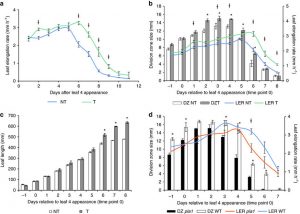 Previously, the rice PLA1 gene encoding a CYTOCHROME P450 (CYP78A) was shown to increase vegetative growth. Sun et al. enhanced expressed maize PLA1 specifically in the leaf growth zone under the control of the GA2ox promoter. Transgenic plants produced larger leaves and larger seed yields than control plants. Kinematic analysis revealed that the transgene increased the duration of cell division in the leaves. These effects are correlated with enhanced levels of auxin and auxin metabolites in the cell division zone. The substrates of CYP78A are not known, but there is no indication that it directly affects auxin levels. Nature Comms. 10.1038/ncomms14752 Tags: Growth Regulation, Signals and Responses
Previously, the rice PLA1 gene encoding a CYTOCHROME P450 (CYP78A) was shown to increase vegetative growth. Sun et al. enhanced expressed maize PLA1 specifically in the leaf growth zone under the control of the GA2ox promoter. Transgenic plants produced larger leaves and larger seed yields than control plants. Kinematic analysis revealed that the transgene increased the duration of cell division in the leaves. These effects are correlated with enhanced levels of auxin and auxin metabolites in the cell division zone. The substrates of CYP78A are not known, but there is no indication that it directly affects auxin levels. Nature Comms. 10.1038/ncomms14752 Tags: Growth Regulation, Signals and Responses
Evidence for Ancient Origins of Bowman-Birk Inhibitors from Selaginella moellendorffii
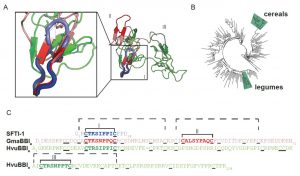 Many seeds produce protease inhibitors that are thought to help protect them from pathogens and predation. One class are the Bowman-Birk Inhibitors (BBIs), which form folded loops that specifically bind to and inhibit trypsin and/or chymotrypsin proteases. Originally characterized from legumes, BBIs were subsequently identified in cereals, although those in cereals lack the chymotrypsin-inhibitory loop. James et al. identified BBI sequences in the lycopod Selaginella maollendorffii and showed that these proteins have trypsin-inhibitory function. They subsequently identified BBI sequences in other angiosperm genomes, and they argue that BBIs have an ancient evolutionary origin but that the genes have been lost in many plant lineages. Plant Cell 10.1105/tpc.16.00831 Tags: Biochemistry, Botany, Evolution
Many seeds produce protease inhibitors that are thought to help protect them from pathogens and predation. One class are the Bowman-Birk Inhibitors (BBIs), which form folded loops that specifically bind to and inhibit trypsin and/or chymotrypsin proteases. Originally characterized from legumes, BBIs were subsequently identified in cereals, although those in cereals lack the chymotrypsin-inhibitory loop. James et al. identified BBI sequences in the lycopod Selaginella maollendorffii and showed that these proteins have trypsin-inhibitory function. They subsequently identified BBI sequences in other angiosperm genomes, and they argue that BBIs have an ancient evolutionary origin but that the genes have been lost in many plant lineages. Plant Cell 10.1105/tpc.16.00831 Tags: Biochemistry, Botany, Evolution
Differential TOR activation and cell proliferation in Arabidopsis root and shoot apexes
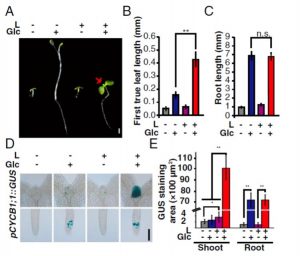 Growth and cell proliferation at the shoot and root apexes are regulated by diverse factors including hormones, nutrients, and light. Previously, the protein kinase TOR (Target of Rapamycin), a transducer of glucose energy signals, was shown to phosphorylate and activate the transcription factor E2Fa, an activator of S-phase genes and cell division, in the root meristem. Li et al. show that TOR similarly transduces the glucose signal in the shoot meristem, but that TOR activation and shoot meristem activation also requires light signals. They further showed that auxin could substitute for light signals in the activation of TOR. Together, these studies show that while glucose is sufficient to promote root meristem activity, light/auxin is additionally required in the shoot. Proc. Natl. Acad. Sci. USA Tags: Growth Regulation, Gene Regulation
Growth and cell proliferation at the shoot and root apexes are regulated by diverse factors including hormones, nutrients, and light. Previously, the protein kinase TOR (Target of Rapamycin), a transducer of glucose energy signals, was shown to phosphorylate and activate the transcription factor E2Fa, an activator of S-phase genes and cell division, in the root meristem. Li et al. show that TOR similarly transduces the glucose signal in the shoot meristem, but that TOR activation and shoot meristem activation also requires light signals. They further showed that auxin could substitute for light signals in the activation of TOR. Together, these studies show that while glucose is sufficient to promote root meristem activity, light/auxin is additionally required in the shoot. Proc. Natl. Acad. Sci. USA Tags: Growth Regulation, Gene Regulation
Role of LOTR1 in Nutrient Transport ($)
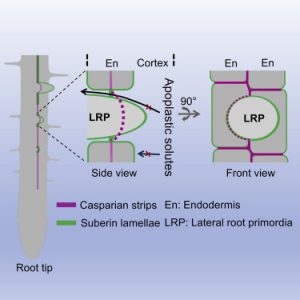 Casparian strips, named after the German botanist Robert Caspary who discovered them, are a cellular feature found in the roots of all higher plants. They are ring-like lignin polymers deposited in the middle of anticlinal cell walls (parallel to the root radius) between endodermal cells. Along with suberin lamellae (glycerolipid polymers), Casparian strips play a regulatory role in nutrient transport. Li et al., show that the lcs2-1 (low calcium sensitive 2-1) mutant, isolated from an ethyl methanesulfonate (EMS) mutagenized M2 population of A. thaliana, has a defect in Casparian strip formation and accumulates enhanced levels of suberin. They showed that lcs2-1 is allelic to another gene that they identified independently, LORD OF THE RINGS 1 (LOTR1) (named after the novel by J.R.R. Tolkien). The authors also showed that suberin deposition functions as an apoplastic diffusion barrier at lateral root emergence sites, where Casparian strips are disrupted. (Summary by Mather Khan). Curr. Biol. 10.1016/j.cub.2017.01.030 Tags: Cell Biology, Development, Genetics, Transport
Casparian strips, named after the German botanist Robert Caspary who discovered them, are a cellular feature found in the roots of all higher plants. They are ring-like lignin polymers deposited in the middle of anticlinal cell walls (parallel to the root radius) between endodermal cells. Along with suberin lamellae (glycerolipid polymers), Casparian strips play a regulatory role in nutrient transport. Li et al., show that the lcs2-1 (low calcium sensitive 2-1) mutant, isolated from an ethyl methanesulfonate (EMS) mutagenized M2 population of A. thaliana, has a defect in Casparian strip formation and accumulates enhanced levels of suberin. They showed that lcs2-1 is allelic to another gene that they identified independently, LORD OF THE RINGS 1 (LOTR1) (named after the novel by J.R.R. Tolkien). The authors also showed that suberin deposition functions as an apoplastic diffusion barrier at lateral root emergence sites, where Casparian strips are disrupted. (Summary by Mather Khan). Curr. Biol. 10.1016/j.cub.2017.01.030 Tags: Cell Biology, Development, Genetics, Transport
Root microbiota drive direct integration of phosphate stress and immunity
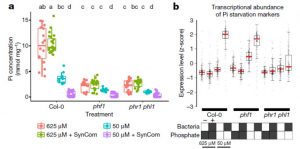 Many of the genes involved in the phosphate-stress response (PSR) have been identified from plants growing on sterile medium. Castrillo et al. examined how the root microbiota affectthe phosphate stress response, and how phosphate affects the association between roots and microbes. Plants deficient in the PSR failed to assemble wild-type microbiota, indicating that the PSR influences the composition of root microbiota. Furthermore, the transcription factor PHR1, a master regulator of PSR, also regulates several plant immune system genes. These findings provide new insight into the intersection between nutritional stress responses, immunity, and microbiota assembly and maintenance. Nature 10.1038/nature21417 Tags: Abiotic Interactions, Biotic Interactions, Genetics, Signals and Responses
Many of the genes involved in the phosphate-stress response (PSR) have been identified from plants growing on sterile medium. Castrillo et al. examined how the root microbiota affectthe phosphate stress response, and how phosphate affects the association between roots and microbes. Plants deficient in the PSR failed to assemble wild-type microbiota, indicating that the PSR influences the composition of root microbiota. Furthermore, the transcription factor PHR1, a master regulator of PSR, also regulates several plant immune system genes. These findings provide new insight into the intersection between nutritional stress responses, immunity, and microbiota assembly and maintenance. Nature 10.1038/nature21417 Tags: Abiotic Interactions, Biotic Interactions, Genetics, Signals and Responses
Mobile MUTE specifies subsidiary cells to build physiologically improved grass stomata ($)
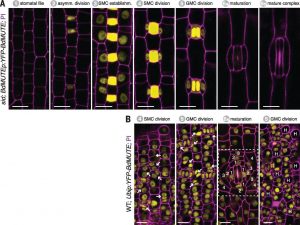 Plants breathe through pores called stomata on leaf surfaces. Stomata are the point of contact with the outside world as they allow gas exchange (e.g., CO2 for photosynthesis) and transpiration. Grasses have evolved to form more efficient stomata in which the guard cells are flanked by additional subsidiary cells. Therefore, grasses form superior 4-celled stomata for efficient functioning; stomata can open wider or close faster in response to varying conditions. Starting with a loss-of-function mutant subsidiary cell identity defective (sid), Raissig et al. describe how in the model grass Brachypodium distachyon a transcription factor called MUTE physically moves from guards cells to adjacent cells to recruit them for formation of the 4-celled stomata complex. The corresponding MUTE protein from Arabidopsis does not move between cells and fails to rescue the loss-of-function sid mutant. (Summary by Nidhi Sharma) Science 10.1126/science.aal3254 Tags: Cell Biology, Development, Genetics
Plants breathe through pores called stomata on leaf surfaces. Stomata are the point of contact with the outside world as they allow gas exchange (e.g., CO2 for photosynthesis) and transpiration. Grasses have evolved to form more efficient stomata in which the guard cells are flanked by additional subsidiary cells. Therefore, grasses form superior 4-celled stomata for efficient functioning; stomata can open wider or close faster in response to varying conditions. Starting with a loss-of-function mutant subsidiary cell identity defective (sid), Raissig et al. describe how in the model grass Brachypodium distachyon a transcription factor called MUTE physically moves from guards cells to adjacent cells to recruit them for formation of the 4-celled stomata complex. The corresponding MUTE protein from Arabidopsis does not move between cells and fails to rescue the loss-of-function sid mutant. (Summary by Nidhi Sharma) Science 10.1126/science.aal3254 Tags: Cell Biology, Development, Genetics
A common developmental program can produce diverse leaf shapes
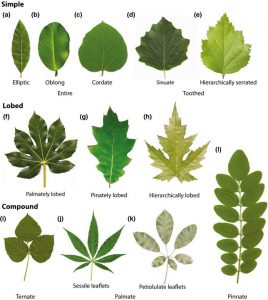 The plethora of diverse leaf shapes results from variations of shared molecular mechanisms that govern leaf growth and development. To better understand the molecular underpinnings of diverse leaf morphologies, Runions et al. constructed a computational model of leaf development that included multiple parameters from prior inferences, molecular data and previous computational models. Factoring in mathematical representations of actively growing leaves, the action of morphogens such as CUS2, PIN1 and auxin at leaf margins, and the contribution of the vascular system into the computational model, the authors were able to construct a model that accurately reflects a diverse array of leaf morphologies. The authors propose that patterns of leaf development emerge from a self-organizing process that is characterized by several feed-back loops; by slightly tweaking the self-organizing process, the authors were able to produce drastically distinct leaf shapes. Future directions include factoring in detailed multi-scale analysis of actively growing leaves and including curved and folded leaves. (Summary by Tyra McCray) New Phytol. 10.1111/nph.14449 Tags: Computational Biology, Development, Growth Regulation
The plethora of diverse leaf shapes results from variations of shared molecular mechanisms that govern leaf growth and development. To better understand the molecular underpinnings of diverse leaf morphologies, Runions et al. constructed a computational model of leaf development that included multiple parameters from prior inferences, molecular data and previous computational models. Factoring in mathematical representations of actively growing leaves, the action of morphogens such as CUS2, PIN1 and auxin at leaf margins, and the contribution of the vascular system into the computational model, the authors were able to construct a model that accurately reflects a diverse array of leaf morphologies. The authors propose that patterns of leaf development emerge from a self-organizing process that is characterized by several feed-back loops; by slightly tweaking the self-organizing process, the authors were able to produce drastically distinct leaf shapes. Future directions include factoring in detailed multi-scale analysis of actively growing leaves and including curved and folded leaves. (Summary by Tyra McCray) New Phytol. 10.1111/nph.14449 Tags: Computational Biology, Development, Growth Regulation
Natural haplotypes of FLM non-coding sequences fine-tune flowering time in two ambient spring temperatures in Arabidopsis
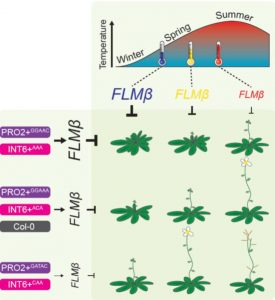 Delaying reproduction until conditions are favorable is a key to success. FLOWERING LOCUS C is a well-known regulator of flowering that delays flowering until after winter vernalization. In the spring, FLOWERING LOCUS M (FLM) fine-tunes flowering time in response to ambient temperatures between 5ºC and 23ºC. Lutz et al. found that the expression level of FLM is temperature dependent and that allelic variants in the promoter and intron that affect expression level are found in Arabidopsis accessions originating from different parts of Europe. Furthermore, when introduced into transgenic plants, these natural variants recapitulated their effects on FLM expression and flowering time. eLIFE 10.7554/eLife.22114 Tags: Abiotic Interactions, Gene Regulation, Genetics, Growth Regulation
Delaying reproduction until conditions are favorable is a key to success. FLOWERING LOCUS C is a well-known regulator of flowering that delays flowering until after winter vernalization. In the spring, FLOWERING LOCUS M (FLM) fine-tunes flowering time in response to ambient temperatures between 5ºC and 23ºC. Lutz et al. found that the expression level of FLM is temperature dependent and that allelic variants in the promoter and intron that affect expression level are found in Arabidopsis accessions originating from different parts of Europe. Furthermore, when introduced into transgenic plants, these natural variants recapitulated their effects on FLM expression and flowering time. eLIFE 10.7554/eLife.22114 Tags: Abiotic Interactions, Gene Regulation, Genetics, Growth Regulation
Divergent evolution driven by pollinators
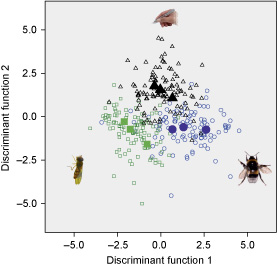 A great variety of plants rely on pollinators to be fertilized successfully. This close relationship is thought to drive evolutionary diversification in plants, making the presence or absence of pollinators in response to climate change an increasingly relevant matter. Gervasi and Schiestl addressed the question of how pollinators influence real-time evolution of adaptive traits in plants with a simple and elegant set of experiments. Starting with a single batch of Brassica rapa plants (self-incompatible), the authors let the plants be pollinized by bumblebees or hoverflies, or manually fertilized them, for nine consecutive generations. The authors found differences in petal traits and floral volatiles associated with the type of pollinator (or not) that visited the plants, and that the evolution of the adaptive traits subsequently affected which pollinators visited the plants. In this way, the authors showed that diversification in plants can be driven by pollinators in just a few generations. (Summary by Gaby Auge) Nature Comms. 10.1038/ncomms14691 Tags: Biotic Interactions, Environmental Plant Biology, Evolution
A great variety of plants rely on pollinators to be fertilized successfully. This close relationship is thought to drive evolutionary diversification in plants, making the presence or absence of pollinators in response to climate change an increasingly relevant matter. Gervasi and Schiestl addressed the question of how pollinators influence real-time evolution of adaptive traits in plants with a simple and elegant set of experiments. Starting with a single batch of Brassica rapa plants (self-incompatible), the authors let the plants be pollinized by bumblebees or hoverflies, or manually fertilized them, for nine consecutive generations. The authors found differences in petal traits and floral volatiles associated with the type of pollinator (or not) that visited the plants, and that the evolution of the adaptive traits subsequently affected which pollinators visited the plants. In this way, the authors showed that diversification in plants can be driven by pollinators in just a few generations. (Summary by Gaby Auge) Nature Comms. 10.1038/ncomms14691 Tags: Biotic Interactions, Environmental Plant Biology, Evolution
Aflatoxin-free transgenic maize using host-induced gene silencing
 Aflatoxins are toxic metabolites produced by some species of Aspergillus fungi that can occur on numerous crop plants. When ingested by animals, aflatoxins cause health problems including liver cancer and stunted growth. Thakare et al. used host-induced gene silencing (HIGS) to block aflatoxin production in maize. They introduced into maize a kernel-specific RNAi construct specific for a gene aflc encoding a key enzyme in alfatoxin biosynthesis. When the resulting plants were inoculated with Aspergillus, no aflatoxin was detectable and no other differences between the engineered and control plants were observable. The authors emphasize that the success of this effort was due to their efforts to identify regions of the aflc gene with no sequence homology to the maize genome. Science 10.1126/sciadv.1602382 Tags: Applied Plant Biology, Biotic Interactions, Gene Regulation
Aflatoxins are toxic metabolites produced by some species of Aspergillus fungi that can occur on numerous crop plants. When ingested by animals, aflatoxins cause health problems including liver cancer and stunted growth. Thakare et al. used host-induced gene silencing (HIGS) to block aflatoxin production in maize. They introduced into maize a kernel-specific RNAi construct specific for a gene aflc encoding a key enzyme in alfatoxin biosynthesis. When the resulting plants were inoculated with Aspergillus, no aflatoxin was detectable and no other differences between the engineered and control plants were observable. The authors emphasize that the success of this effort was due to their efforts to identify regions of the aflc gene with no sequence homology to the maize genome. Science 10.1126/sciadv.1602382 Tags: Applied Plant Biology, Biotic Interactions, Gene Regulation
Signatures of local adaptation in lowland and highland teosintes from whole genome sequencing of pooled samples ($)
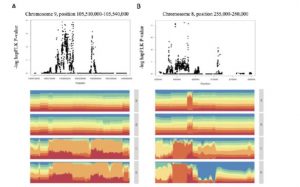 Teosinte, the ancestor of maize, grows in a range of environments in México. Teosinte parviglumis (Zea mays ssp parviglumis) is more prevalent in lowland regions while teosinte mexicana (Zea mays ssp mexicana) occupies highland territory (>2000 m above sea level). Admixture between parviglumis and mexicana can occur at mid-elevations. Fustier et al. sampled an altitudinal gradient of teosinte populations and then used pooled sequencing populations of low, mid and high elevations. The authors used two population differentiation methods and correlations of allele frequencies with environmental variables to find outlier SNPs that tended to cluster together and 47 candidate regions were identified. The authors were able to recover a previously characterized inversion in chromosome 1. A soft sweep was found in a locus involved in leaf macrohair variation, a phenotype that is characteristic of teosinte mexicana and that is absent in lowland teosinte parviglumis. Finally, several outlier SNPs tthat colocalized with loci involved in root system architecture, heavy metal tolerance and nutrient deficiencies point to a significant role of soil physico-chemical properties as major drivers of teosinte local adaptation. (Summary by Rubén Rellán-Álverez group) Mol. Ecol. 10.1111/mec.14082 Tags: Abiotic Intereractions, Botany, Genetics, Genomics, Evolution
Teosinte, the ancestor of maize, grows in a range of environments in México. Teosinte parviglumis (Zea mays ssp parviglumis) is more prevalent in lowland regions while teosinte mexicana (Zea mays ssp mexicana) occupies highland territory (>2000 m above sea level). Admixture between parviglumis and mexicana can occur at mid-elevations. Fustier et al. sampled an altitudinal gradient of teosinte populations and then used pooled sequencing populations of low, mid and high elevations. The authors used two population differentiation methods and correlations of allele frequencies with environmental variables to find outlier SNPs that tended to cluster together and 47 candidate regions were identified. The authors were able to recover a previously characterized inversion in chromosome 1. A soft sweep was found in a locus involved in leaf macrohair variation, a phenotype that is characteristic of teosinte mexicana and that is absent in lowland teosinte parviglumis. Finally, several outlier SNPs tthat colocalized with loci involved in root system architecture, heavy metal tolerance and nutrient deficiencies point to a significant role of soil physico-chemical properties as major drivers of teosinte local adaptation. (Summary by Rubén Rellán-Álverez group) Mol. Ecol. 10.1111/mec.14082 Tags: Abiotic Intereractions, Botany, Genetics, Genomics, Evolution




Leave a Reply
Want to join the discussion?Feel free to contribute!